
Our record setting Round the Isle of Wight voyage
The Artemis Challenge has proved its fair share of excitement for us over the years. The first year we sailed it with Mike Sanderson aboard Pindar, an early outing for the Juan K penned IMOCA 60, culminated in a sorry dismasting soon after passing the Needles. This year our Artemis Challenge was more positive and much more exhilarating.
Traditionally the Artemis Challenge has been a lap of the Isle of Wight during Aberdeen Asset Management Cowes Week, solely for the IMOCA 60s. But this year, with many of the Open 60 teams in the final throws of preparation for this autumn’s Vendee Globe, so the MOD 70 trimarans were invited, the Artemis Challenge fitting in nicely between the end of the one design trimarans’ Krys Ocean Race and the start of their European Tour.
Surprisingly for a man who has won the OSTAR and the Route du Rhum, who has twice won the Vendee Globe and three times La Solitaire du Figaro, Michel Desjoyeaux had never visited Aberdeen Asset Management Cowes Week before and the last time he raced in the Solent was when Mumm 36s were at their peak and he was competing in a French team with the likes of Jimmy Pahun and Gery Trentesaux.
While the Artemis Challenge in previous years has been in relatively benign conditions, this year from some way out the forecast was indicating 20+ knots from the south and the prospect of beating the outright record for the lap of the Isle of Wight seemed plausible, although in the final forecast in the morning conditions appeared to have dropped slightly. The time to beat was set in 2001 by the late Steve Fossett and the crew of the 125ft maxi-catamaran PlayStation and stood at 2 hours 33 minutes 55 seconds. According to Brian Thompson they had been on stand-by for three months to achieve that record.
The Artemis Challenge is also famous for the VIP guests it pops on the boats from regular Zara Phillips, who this year fired the start gun for the race, to Euan McGregor and Bryan Adams and the Weasley brothers from the Harry Potter films. This year it was the turn of the British Olympic sailors with Nick Dempsey and the Women’s Match Racing team sprinkled among the IMOCA 60s.
On board Foncia, joining Michel Desjoyeaux, currently fastest singlehanded monohull sailor around the world (84 days 3 hours 9 minutes), was appropriately Sir Robin Knox-Johnston, the first man to sail singlehanded non-stop around the world back in 1969 in the Sunday Times Golden Globe aboard Suhaili (312 days), but also a former holder of the Jules Verne Trophy with Peter Blake onboard ENZA New Zealand who set a time of 74 days 22 hours 18 minutes in 1994. Also with us was double Olympic silver medallist Ian Walker, recently returned from his second lap of the planet in the Volvo Ocean Race. Despite the numerous records held between Desjoyeaux and Knox-Johnston, Walker probably holds the highest peak speed of the three, having notched up 43 knots during the Volvo Ocean Race.
The start gun saw the four boats in the Artemis Challenge set sail at 1000 from the Royal Yacht Squadron line for an anti-clockwise lap of the Isle of Wight. With the wind in the southwest, on Foncia we started to leeward of our direct opposition, the Sidney Gavignet-steered MOD70 Musandam-OmanSail. On the wind on port tack cruising along at a useful 20-22 knots, Foncia was initially leading as we headed off west down the Solent, but the Omani team was pointing higher and passing Beaulieu began overhauled Foncia.
With Desjoyeaux cool as a cucumber on the helm, sat in one of the bucket seats at either side of the cockpit, Foncia was being ably handled by her young crew. With leading Figaro sailor and Banque Populaire maxi tri crewman Thierry Chabagny navigating, her French crew comprised Antoine Carraz, Julien Falxa, Alban Rossolin, Nicolas Texier and Denis Juhel.
Meanwhile we were effectively ballast, positioned forward on the weather float up just aft of the forward crossbeam, heading in towards the main hull in the lulls and back out to the weather float again in the gusts.
With the constant blast of howling apparent wind, we were surprisingly dry on our perch on the netting 15ft above the water. Initially during tacks we were tippytoeing around the back of the cockpit, but eventually started taking the more direct route dipping under the foot of the jib, ahead of the towering rotating wingmast. As with the ORMA 60s, which the MOD70s have replaced, the wingmast is usually canted to weather and this is operated via two giant hydraulic rams (mounted laterally in the cockpit along the trailing edge of the aft beam) hitched up to the shrouds, the rams driven by the twin pedestals in the cockpit. The hydraulic ram valve is released just before the manoeuvre, causing the mast to drop to leeward, into the correct position for the new tack.
After six tacks we reached Hurst Castle 44 minutes after starting and as usual the ride got a little bumpy around the Shingles as we tacked out towards the Needles. At this point Musandam-Oman Sail was leading, having shown us a clean pair heels upwind, but surprisingly we were able to speed past her as she fluffed her final tack at the Needles and, stopped by a wave, was caught in irons.
With Foncia still under full main and staysail, we turned the corner at the Needles, cracked sheets slightly and thundered off towards St Catherine’s Point on a tightish reach, boat speed now up to 26-28 knots - no need to steal inshore or really to worry much about the tide when you are at warp speed. As this point the human movable ballast edged back along the netting towards the aft beam.
After around just 18-20 minutes Foncia had reached St Catherine’s Point where Desjoyeaux did a masterful job steering us through the confused seas. Bearing away further we hoisted and then unfurled the genniker. At this point the speed was edging above 30 knots and while we were still dry up to weather, the occasional blast of spray would fire horizontally back down the main hull towards the crewmen manning the pumps aft of the cockpit cuddy.
Having taken the best part of an hour to reach the Needles, impressively after another hour were already passing No Man’s Land Fort at the eastern end of the Solent. Here we passed ICAP Leopard and Hugo Boss coming out for a looksie. On board we now had the outright round the Isle of Wight record firmly in our sights with 33 minutes left to cover the final nine miles back to Cowes.
The fourth quadrant of our rapid lap of the Isle of Wight proved to be the gustiest with Desjoyeaux manning the traveller from his comfy helming position, but with other crew at the ready in the cockpit to ease sheets in the big gusts. Around Ryde in particular there were a couple of big prolonged puffs that saw most of Foncia’s daggerboard lift out of the water. Fortunately this is regular fare for MOD70 crews and for us, the ballast on board, this required one's heels to be dug firmly into the netting to avoid sliding down towards the mainhull. Typically the ride when the mainhull is fully airborne, isn’t nearly as alarming as it might appear from off the boat.
Returning to the central Solent with Ian Walker moving into the cockpit to assist on tactics, we had some fun threading our way through the Cowes Week fleet at 30 knots, some of the smaller monohulls appearing to be at a virtual standstill. With big grins throughout the crew, Foncia recrossed the Squadron line 2 hours 21 minutes and 25 seconds after departing, breaking the second by 12 minutes 30 seconds, making our average speed for the 50 mile lap 21.1 knots - not overly quick compared to the Banque Populaire maxi tri’s 32.94 knot average across the north Atlantic from New York to the Lizard but still a worthy record (still subject to ratification by the World Sailing Speed Record Council).
The lap of the Isle of Wight was Ian Walker’s first experience of racing large multihull. “We have had a great day. It is not every day you get to go sailing with Michel Desjoyeaux and Robin Knox-Johnston. Mich has got a great team - a young team, all keen. I am impressed with the boats, everything seems to work, they are incredibly manoeuvrable. I was amazed how quickly you could tack and gybe – everything seemed incredibly easy, but maybe that’s just because the crew is so good.”
After we finished, we sailed up and down the Solent and got an opportunity to helm. Ian Walker seemed to enjoy this: “It is definitely the most comfortable place on the boat. You have a nice little seat there and I think it is a boat where you have to concentrate a lot, because unlike a VO70, where you just watch the numbers and keep it on the numbers, this is more about feel and the angle of heel of the boat and you can easily be going 3-4 knots slower than potential, so it definitely rewards accurate steering and guys who know what they are doing in multihulls.”
At present Walker is seeing if his and Jamie Boag’s company High Aspect can again win the contract to campaign another Abu Dhabi boat in the Volvo Ocean Race, but an MOD70 campaign would be an interesting plan B. “It will be interesting to see what unfolds. I think they have done a great job of getting this [the MOD70] off the ground. The Transatlantic Race sounded amazing. They have got the race around Europe. They desperately need more non-French boats to make it really international to add to Oman. But they are doing a lot of the right things, keeping the cost down, etc. They are a direct competitor to the Volvo in many ways.”
Sir Robin Knox-Johnston spent the entire morning with a huge grin on his face. Aside from his ENZA New Zealand experience 18-9 years ago, Knox-Johnston was a key player in the very early development of maxi-multihulls in the 1970s with boats like British Oxygen, his 1974 doublehanded Round Britain Race winner, Sea Falcon and during the mid-1980s the 60ft catamaran British Airways – all catamarans.
“It is phenomenal development. These boats now really do have a considerable increase in speed than we were capable of at that time. The development has been phenomenal.” On ENZA the top peak speed they hit was 32 knots during a squall off New Zealand. On Foncia today we topped 35 knots.
“I think the interesting thing is that you can maintain a so much better average speed now,” Knox Johnson continues. “This boat is so easily driven and you don’t feel under any strain when you are really pushing. We were doing 25 knots and you don’t feel the boat is under strain at all whereas on ENZA at about 25-28 knots we did feel she was under strain. This boat just seems so much easier.
“It is phenomenal. It is a great privilege to sail with a superb skipper and a really good crew. That struck me, just how good the crew work was. It was first class - they just quietly on with their jobs with any screaming or shouting – very impressive.”
We would like to thank Michel Desjoyeaux and the Foncia crew for allowing us to be part of a voyage that will go down in the history books.
Video of this follows tomorrow
 |
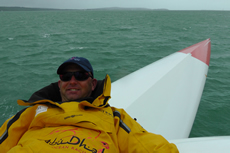 |
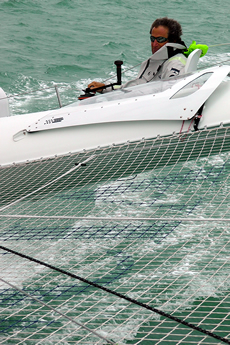 |
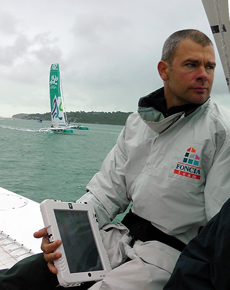 |
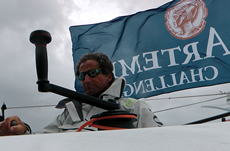 |
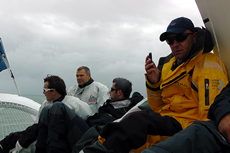 |
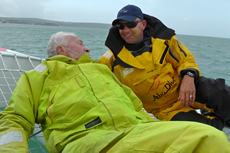 |
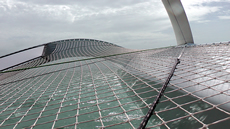 |
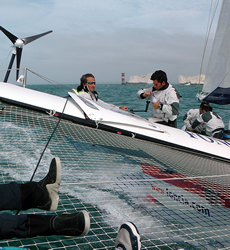 |
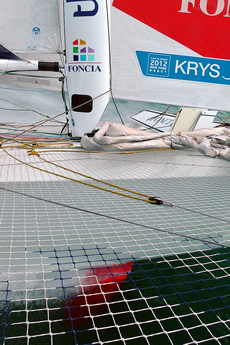 |
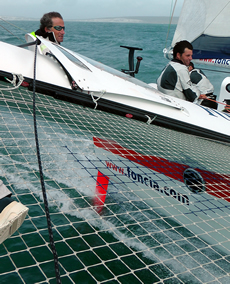 |
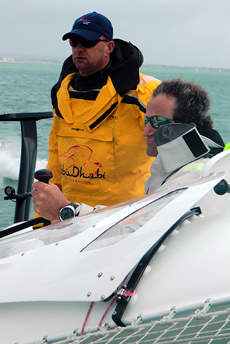 |
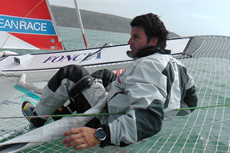 |
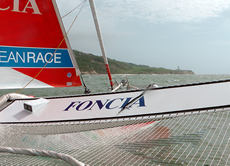 |
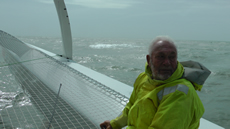 |
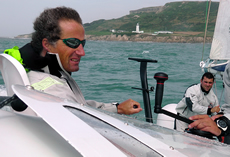 |
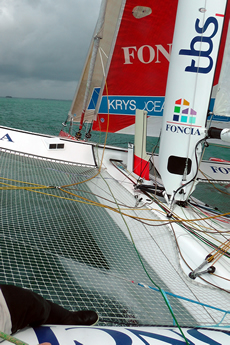 |
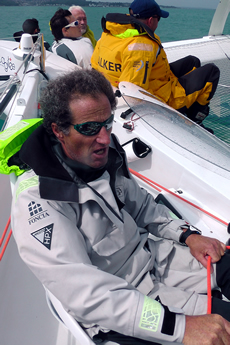 |
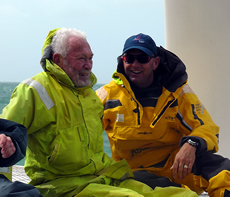 |
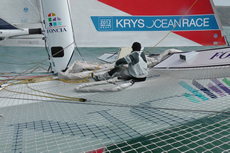 |
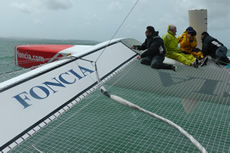 |
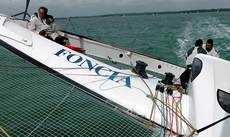 |
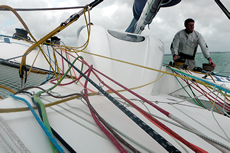 |
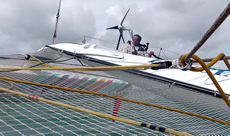 |
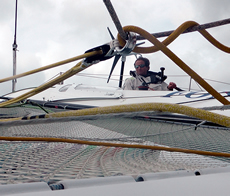 |
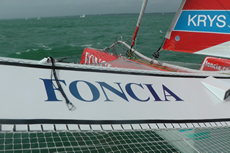 |













Latest Comments
atninc 28/08/2012 - 13:27
Great day sail with the greatests! job well done James!Add a comment - Members log in